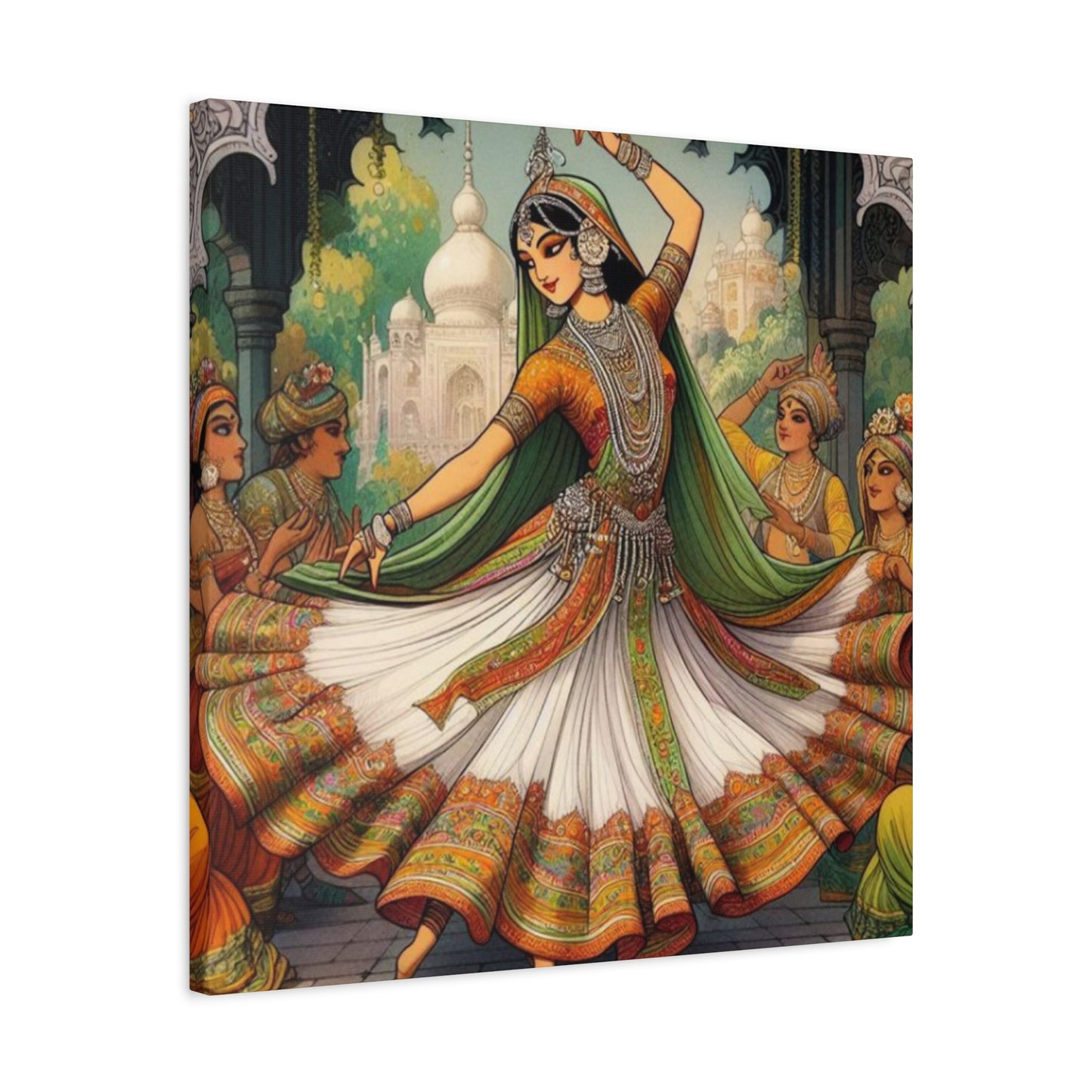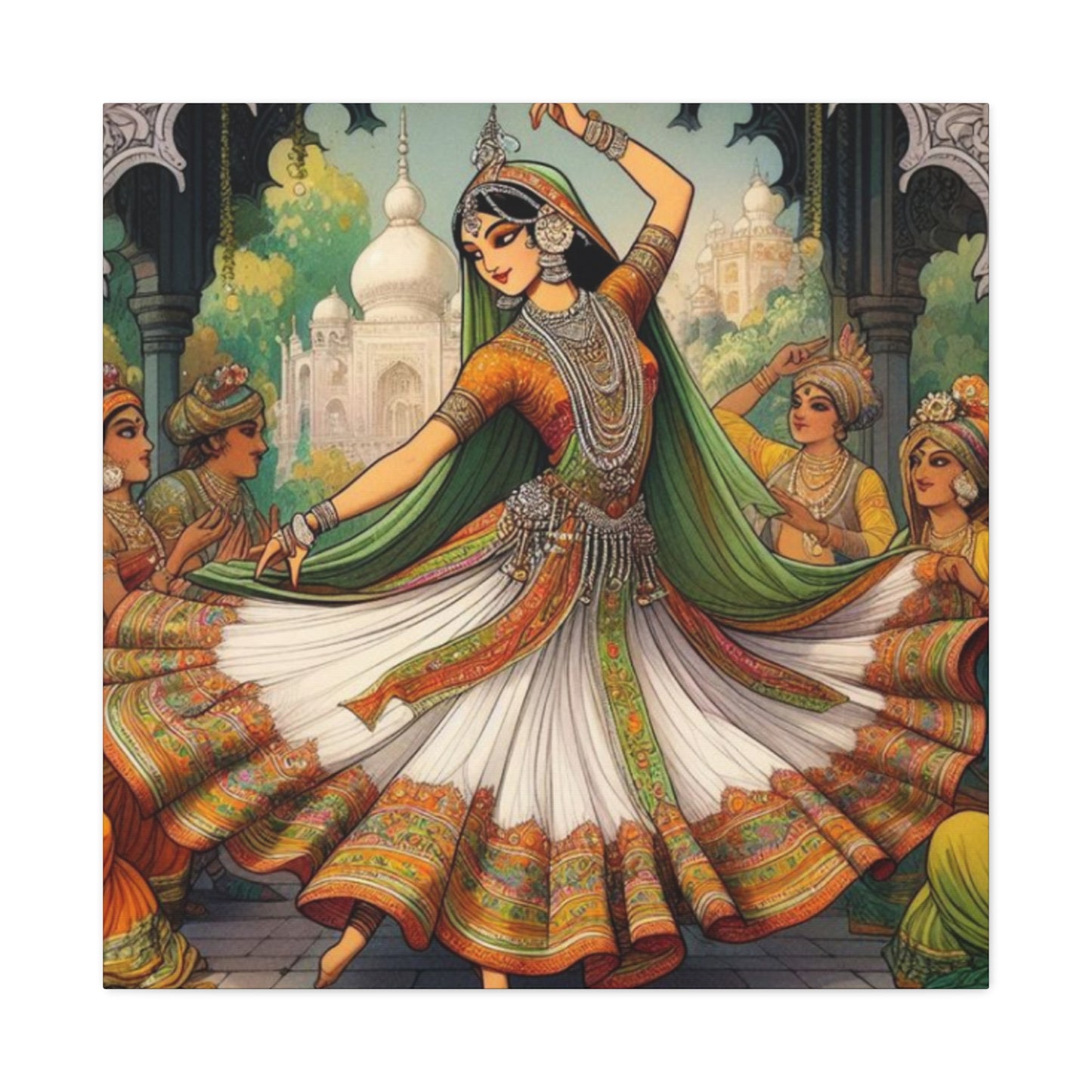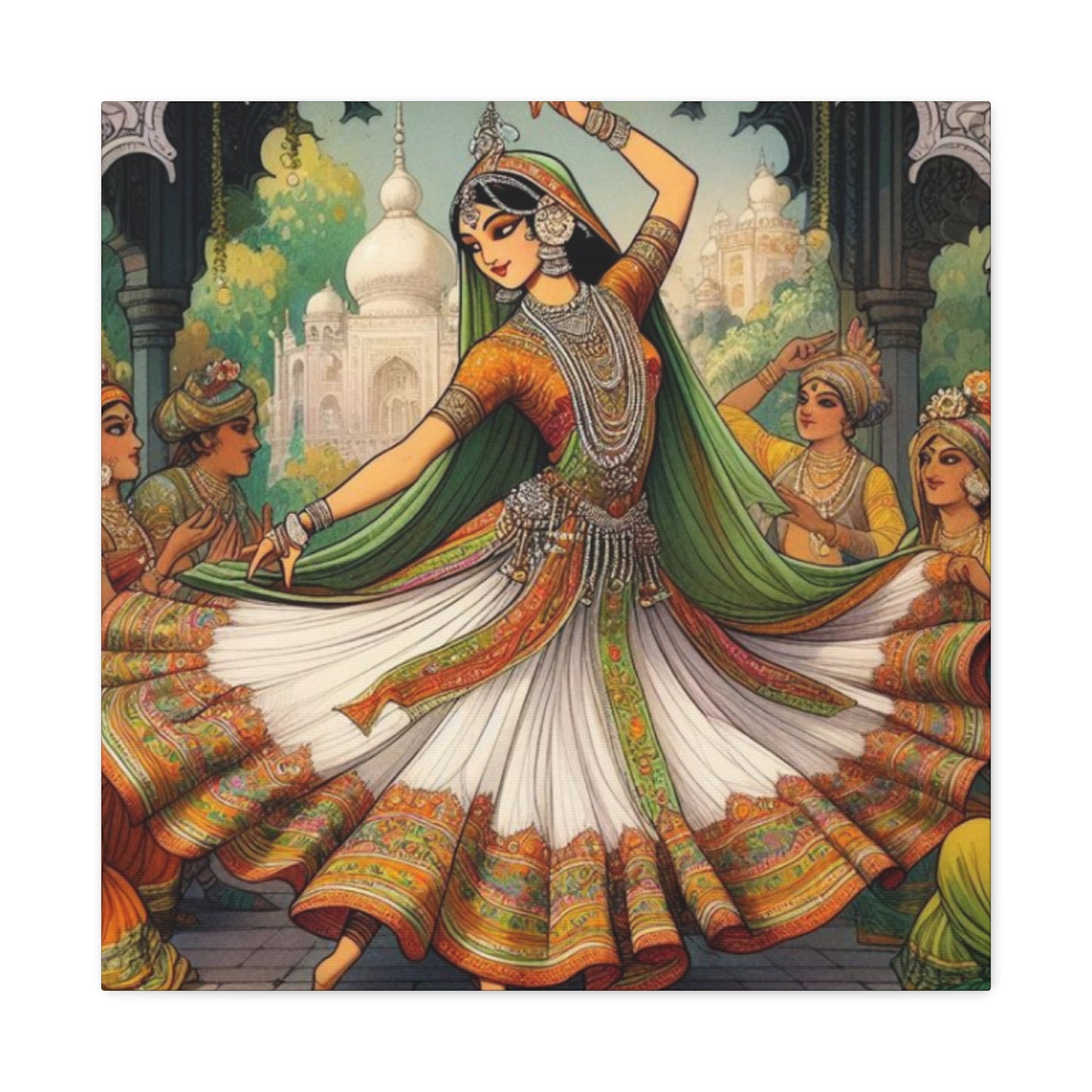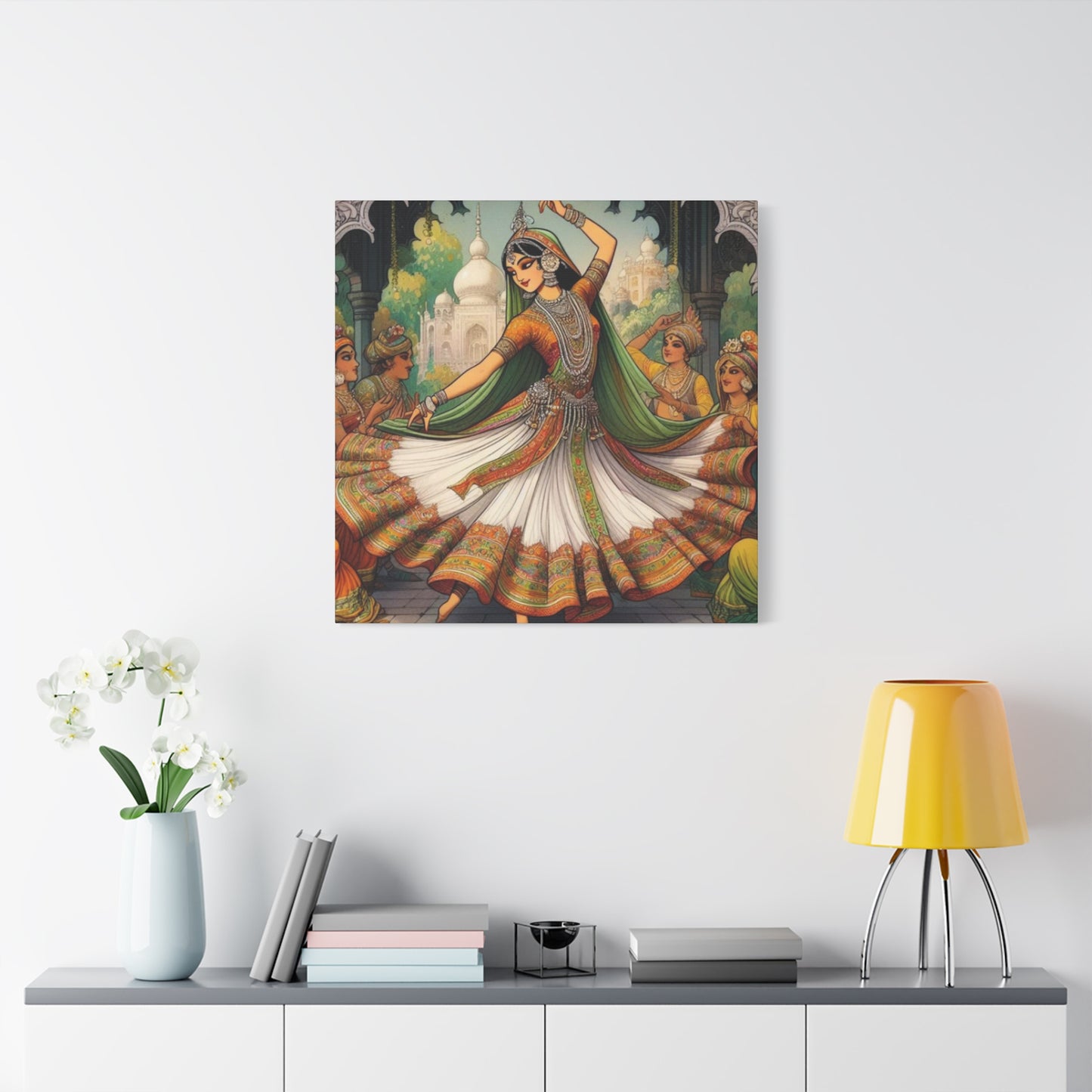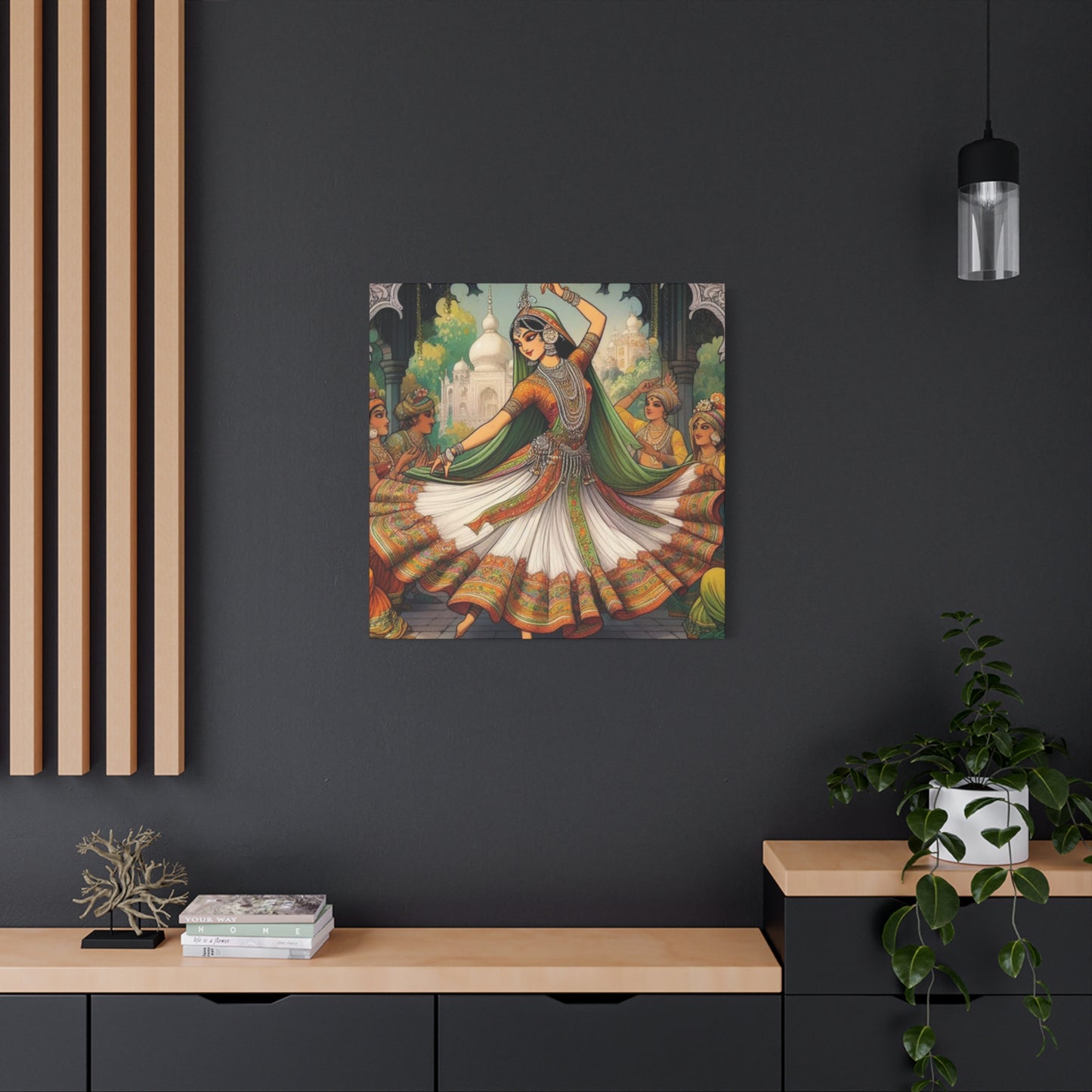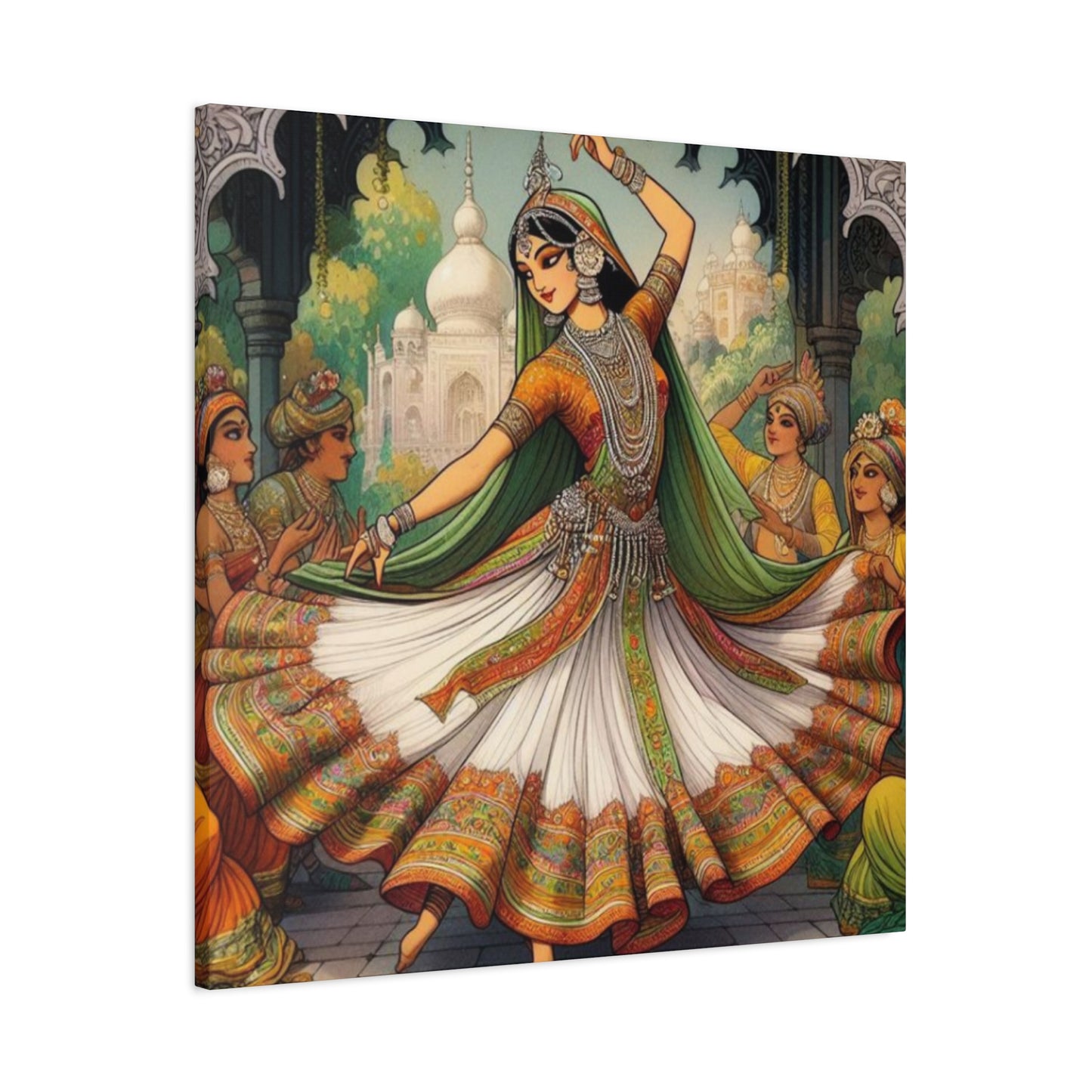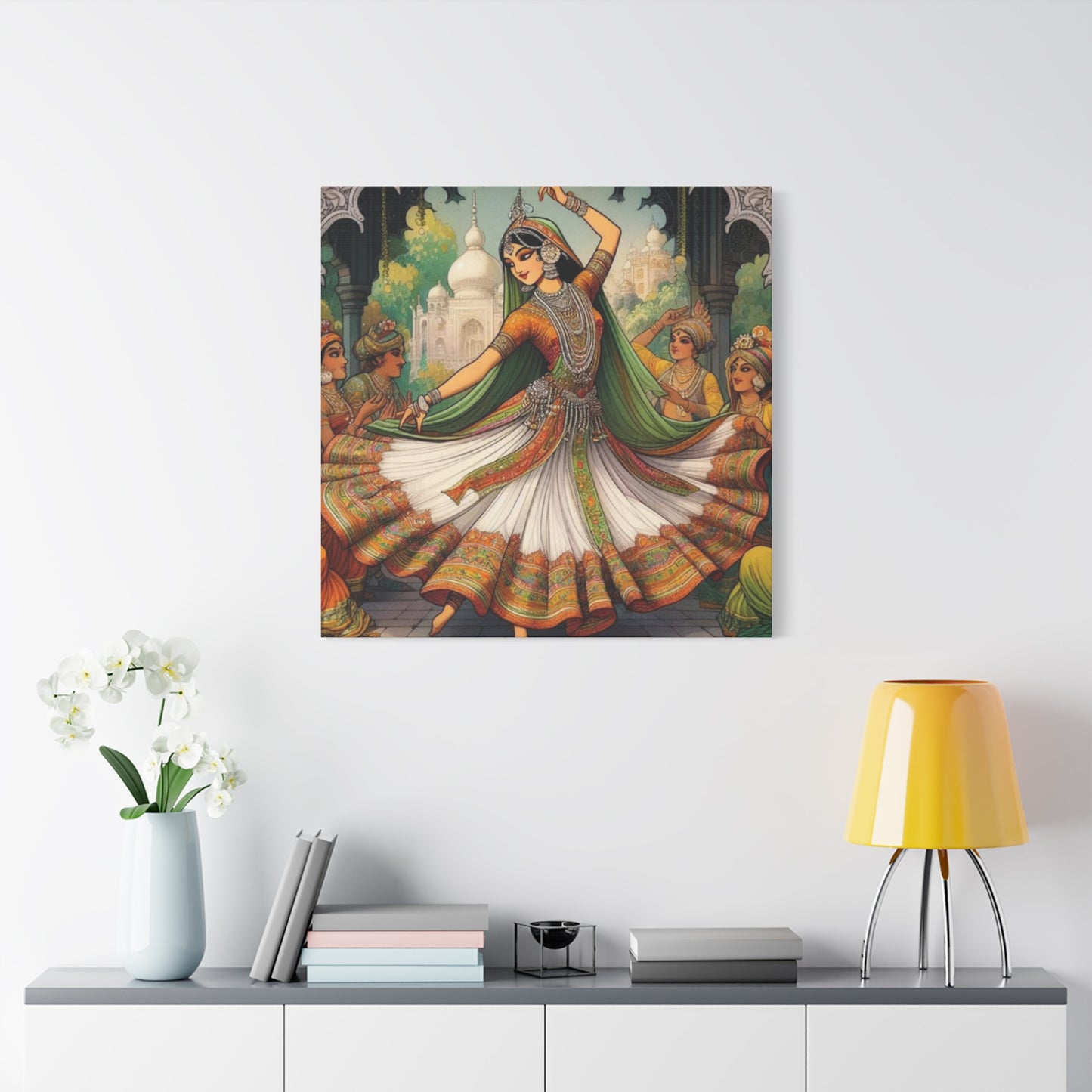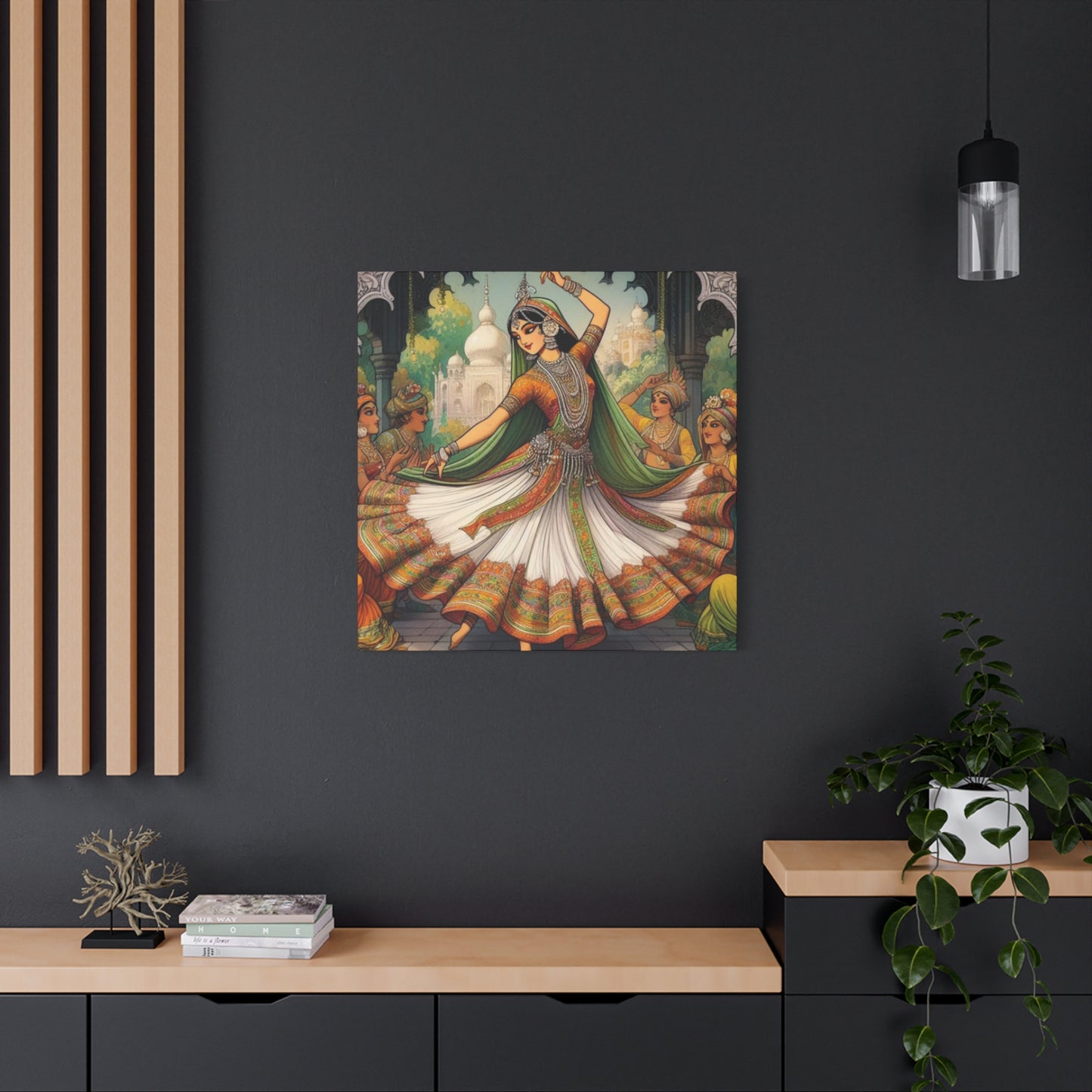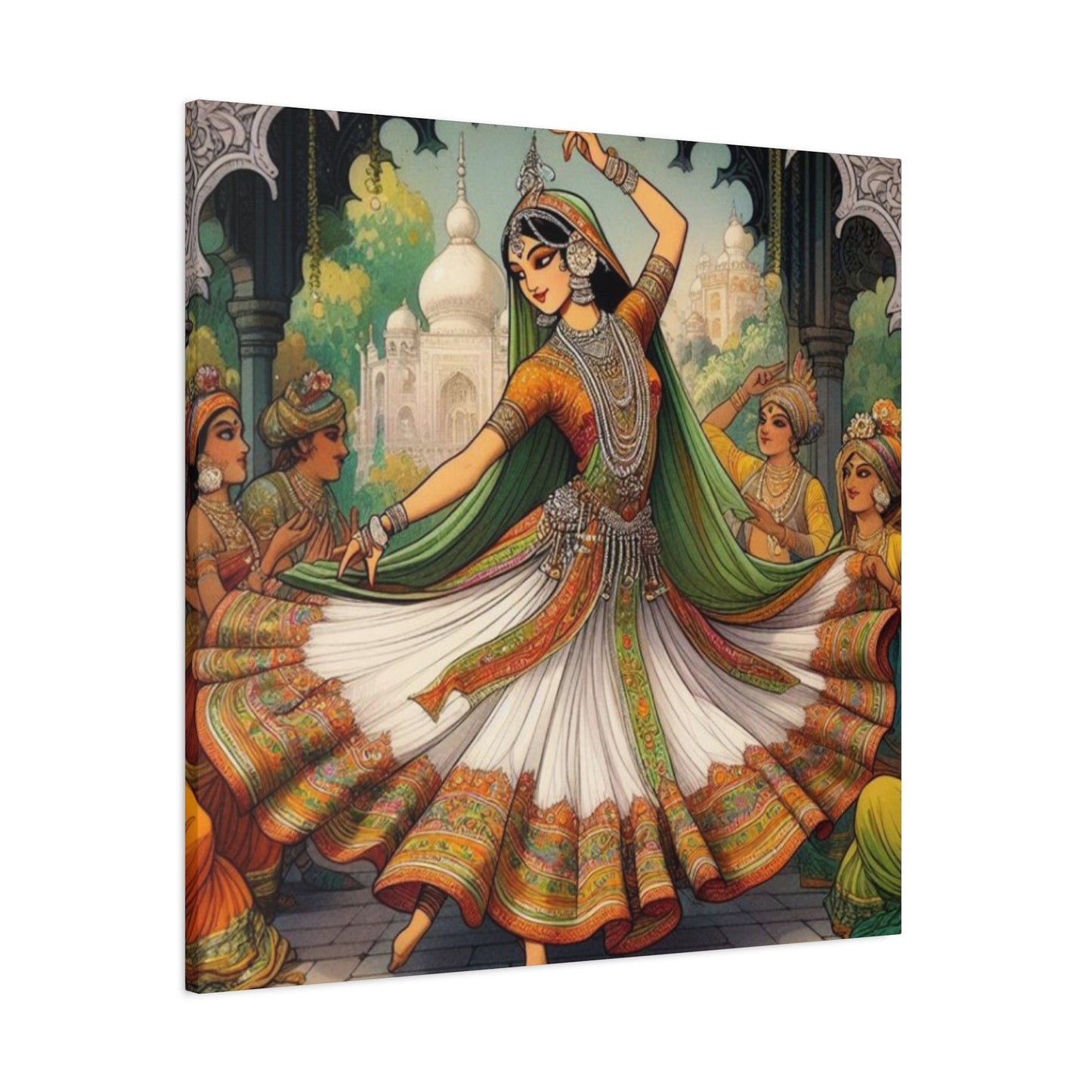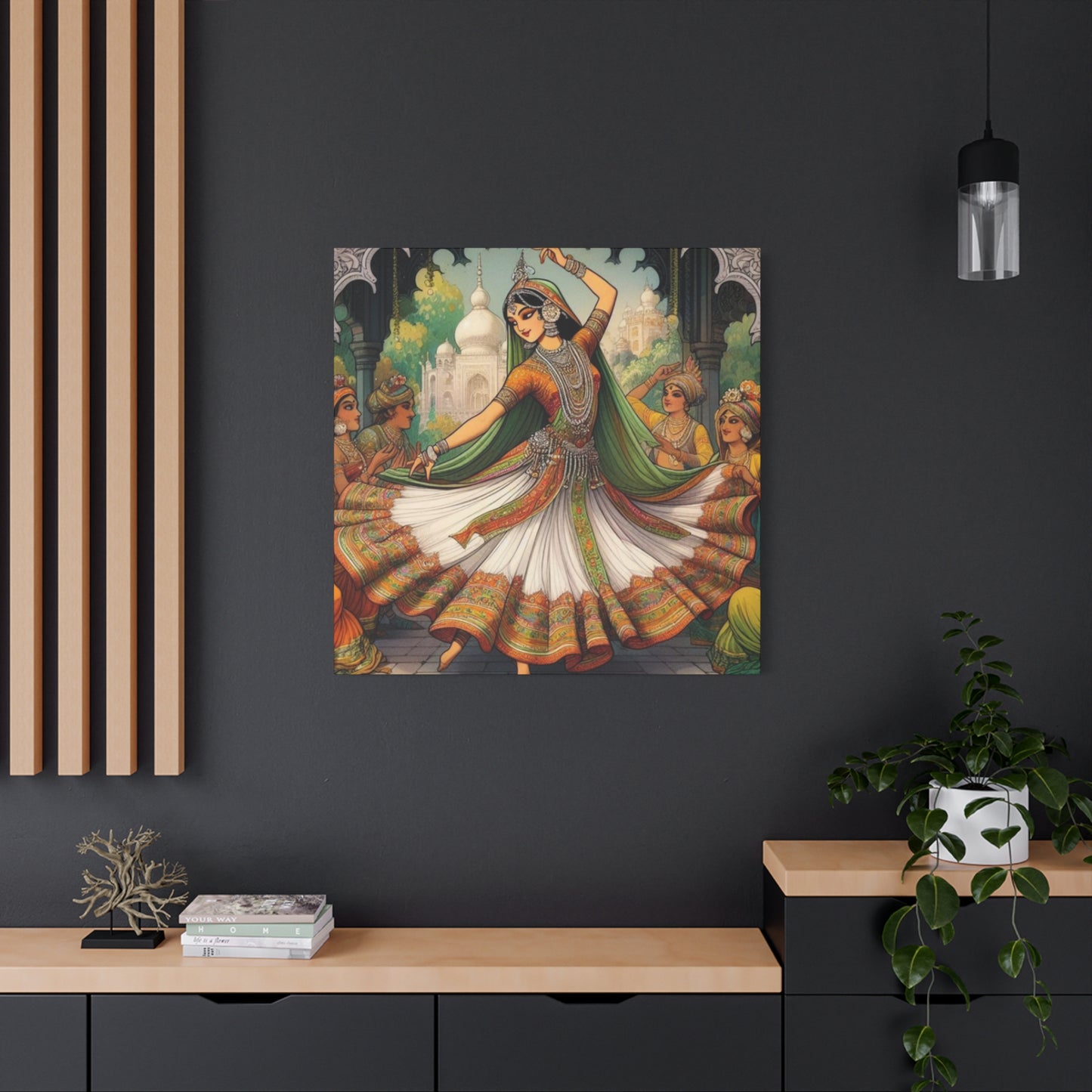Indian Queen Dancing Wall Art: Elevating Your Home with Royal Aesthetic Elegance
Indian queen dancing wall art represents one of the most captivating and visually striking elements of interior design that brings the richness of South Asian heritage directly into modern living spaces. This unique form of artistic expression combines traditional dance movements with royal portraiture, creating pieces that tell stories of dynasty, grace, and cultural pride. The depiction of Indian queens and royalty engaged in classical dance forms has become increasingly popular among homeowners seeking to infuse their environments with sophistication and cultural authenticity.
The charm of Indian queen dancing wall art lies in its ability to transcend mere decoration and become a conversation starter that reflects the refined tastes of those who appreciate cultural artistry. These pieces typically showcase elaborate costumes adorned with jewels, intricate patterns, and dramatic poses that capture the essence of Bharatanatyam, Kathak, or other classical Indian dance forms. The regal bearing and expressive movements frozen in time on canvas create an atmosphere of elegance that no ordinary wall hanging can replicate.
When you choose to display Indian queen dancing wall art in your home, you are making a conscious decision to celebrate and honor the artistic traditions that have flourished for centuries across the Indian subcontinent. This choice goes beyond aesthetic preference and represents an appreciation for the historical narratives, cultural values, and artistic mastery that these depictions embody. Each brushstroke, each fold of a saree, each gesture of a hand tells a story that connects viewers to a heritage that is both ancient and continuously evolving in contemporary artistic practice.
The growing popularity of Indian queen dancing wall art in households worldwide demonstrates how traditional art forms can find relevance and appreciation in modern interior design schemes. Whether displayed in minimalist contemporary spaces or traditional home settings, these artworks create focal points that draw attention and admiration. The versatility of these pieces allows them to complement various design aesthetics while maintaining their authentic cultural essence and visual impact.
Evolution of Indian Queen Dancing Art Forms and Traditions
The historical journey of Indian queen dancing wall art is deeply intertwined with the royal courts and cultural centers that flourished throughout the Indian subcontinent. For centuries, dance was considered one of the highest art forms, reserved for royal courts and temples where the most accomplished dancers performed for nobility and religious devotees. The queens and royal women of Indian kingdoms were often trained in classical dance, and their performances became legendary tales passed down through generations. These historical accounts of grace, beauty, and artistic mastery eventually inspired artists to capture these moments on canvas.
During the Mughal period, which spanned several centuries, the courts became centers of artistic innovation where classical dance forms evolved and flourished. Emperors and their queens patronized the finest dancers and musicians, creating an environment where art could reach its highest expression. The depictions of these royal dancers eventually became subjects of interest for painters who sought to immortalize the beauty and elegance of these performances. The combination of Mughal artistic influences with Indian classical traditions created a unique aesthetic that continues to captivate viewers today.
The Victorian era and the subsequent colonial period saw a shift in how Indian art forms were perceived and documented. Western artists who encountered Indian dance became fascinated by the complexity of movements, the ornate costumes, and the expressiveness of the dancers. This cross-cultural exchange led to new interpretations and representations of Indian queens engaged in dance, blending Eastern artistic traditions with Western painting techniques. These hybrid approaches eventually contributed to the diverse styles of Indian queen dancing wall art that we see in contemporary markets.
The independence movement and post-independence period witnessed a renaissance in Indian cultural appreciation, leading many artists to focus specifically on celebrating indigenous art forms and royal heritage. Indian queen dancing wall art became a medium through which national pride and cultural identity could be expressed visually. Artists began more intentionally documenting and reimagining the stories of historical queens and their accomplishments, ensuring that these narratives would be preserved for future generations. This period marked a significant shift in how these artworks were created, valued, and collected by people across India and eventually worldwide.
Modern artistic movements have continued to evolve the representation of Indian queens in dance-related wall art. Contemporary artists blend traditional painting techniques with modern interpretive styles, sometimes creating abstract or semi-abstract representations that maintain the essence of classical dance while offering fresh visual experiences. The digital age has also introduced new possibilities for creating and reproducing Indian queen dancing wall art, making these pieces more accessible to people across different economic backgrounds and geographic locations. This democratization of access has significantly increased the demand for and appreciation of these artworks globally.
Exploring Different Styles and Artistic Approaches to Indian Queen Dancing Wall Art
The world of Indian queen dancing wall art encompasses a remarkably diverse range of artistic styles and interpretative approaches, each offering unique perspectives on the themes of royalty, dance, and cultural expression. Traditional oil painting remains one of the most respected mediums for these artworks, offering depth, richness, and a timeless quality that appeals to collectors seeking classical aesthetics. These paintings often feature detailed representations of jewelry, textile patterns, facial expressions, and dance postures that require exceptional skill and decades of artistic practice to master.
Watercolor representations of Indian queen dancing wall art present a more ethereal and delicate aesthetic compared to their oil painting counterparts. The translucency of watercolors allows artists to create nuanced color gradations that suggest movement and grace while maintaining an aura of mystique around the royal dancer. This style often emphasizes the flowing elements of traditional costumes, such as the pleats of a saree or the movements of ornamental scarves, using minimal but strategic brushstrokes to convey maximum elegance and fluidity.
Acrylic painting has become increasingly popular for creating Indian queen dancing wall art due to its versatility, faster drying time, and ability to achieve both bold and subtle effects. Artists working in acrylics often experiment with mixed media approaches, incorporating elements such as gold leaf, metallic paints, or textile elements to add dimensional depth to their compositions. This contemporary approach to creating Indian queen dancing wall art has attracted younger artists and allowed for more experimental and unconventional interpretations of traditional themes.
Digital art and modern graphic design approaches have introduced entirely new dimensions to Indian queen dancing wall art representation. Digital artists can create photorealistic depictions of classical dancers or venture into fantastical interpretations that blend historical elements with imaginative new concepts. The advantage of digital creation lies in its ability to be easily modified, reproduced, and adapted to different sizes and formats, making digital Indian queen dancing wall art highly accessible to consumers seeking customizable options for their specific spaces.
The Cultural and Spiritual Significance of Classical Indian Dance Forms Depicted in Wall Art
Classical Indian dance forms represent some of the oldest and most sophisticated performance arts in human civilization, with roots extending back thousands of years into ancient temple rituals and royal court traditions. When these dance forms are captured in wall art representations, they carry with them profound spiritual and cultural meanings that transcend mere aesthetic appreciation. The various classical Indian dance forms each possess distinct characteristics, regional origins, and spiritual significance that contribute to the meaning and impact of Indian queen dancing wall art depicting these traditions.
Bharatanatyam, originating from Tamil Nadu and traditionally performed in Hindu temples, represents one of the most refined classical dance forms in Indian culture. The precise hand gestures, facial expressions, and body movements of Bharatanatyam convey complex emotional narratives and spiritual concepts. When Indian queen dancing wall art depicts a performer executing Bharatanatyam movements, it communicates themes of devotion, grace, and disciplined artistry. The costumes typically feature heavily pleated sarees, abundant jewelry, and distinctive makeup that creates a visually stunning representation of this sacred tradition. Artists who create these depictions often invest considerable research into accurately portraying the mudras (hand gestures) and postures that are fundamental to the dance form's integrity and meaning.
Kathak, the classical dance tradition that flourished in the royal courts of Northern India, carries with it the elegance and sophistication associated with Mughal-influenced aesthetics. The graceful spins, intricate footwork, and narrative expressions characteristic of Kathak create visually dynamic representations in wall art. Indian queen dancing wall art depicting Kathak often emphasizes the flowing movements of longer skirts and the dramatic storytelling quality of the performance. The connection between Kathak and royal court tradition makes it particularly apt for depicting Indian queens and nobility, as many historical queens were accomplished Kathak performers who used the art form to express themselves and entertain court audiences.
Odissi, originating from Odisha and characterized by its lyrical quality and sensuous body movements, offers a distinctly different aesthetic from other classical Indian dance forms. The tribhanga posture, where the body is curved in three distinct angles, creates visually striking compositions when portrayed in Indian queen dancing wall art. The costumes associated with Odissi feature specific colors, patterns, and jewelry arrangements that identify the dance form immediately to knowledgeable viewers. Artists depicting Odissi in wall art often emphasize the graceful curves and flowing movements that define this tradition's visual vocabulary.
Manipuri, the classical dance form of Manipur in the northeastern region of India, presents a more serene and intimate aesthetic in wall art representations. The soft, flowing movements and the emphasis on gentle expressions create a distinctly different mood compared to the more dramatic classical dance forms. When Indian queens are depicted performing Manipuri, the wall art often conveys a sense of peace, spiritual devotion, and connection to nature. The costumes and jewelry associated with Manipuri have distinctive regional characteristics that contribute to the visual uniqueness of these artistic representations.
The spiritual dimensions of Indian queen dancing wall art extend beyond the specific dance forms depicted to encompass broader themes of divine feminine energy and cultural consciousness. In Hindu tradition, dance is considered a path to spiritual enlightenment and a form of worship. Classical dancers are sometimes viewed as embodying divine qualities and serving as conduits for spiritual expression. When these concepts are reflected in Indian queen dancing wall art, the pieces take on additional layers of meaning that appeal to viewers seeking spiritual connection and cultural grounding in their living spaces.
Characteristics and Design Elements That Define Indian Queen Dancing Wall Art
Indian queen dancing wall art possesses several distinctive characteristics and design elements that work together to create its immediately recognizable and captivating visual identity. Understanding these elements provides valuable context for appreciating the artistry involved in creating these pieces and for making informed decisions when selecting artworks for personal collections and home decoration. The distinctive features of Indian queen dancing wall art make these pieces stand out dramatically in interior spaces and serve as powerful expressions of cultural sophistication.
The costumes depicted in Indian queen dancing wall art represent perhaps the most visually striking element of these compositions. Traditional dance costumes feature elaborate sarees draped in specific patterns determined by regional and dance form-specific traditions. The sarees are typically constructed from rich fabrics such as silk or cotton, often adorned with gold or silver threading, intricate brocade patterns, and ornamental borders. Artists rendering these costumes in wall art must possess detailed knowledge of how these textiles drape and move, requiring years of observation and practice to achieve authenticity and elegance in their representations.
Jewelry and ornamental adornments constitute another essential visual element in Indian queen dancing wall art. Classical dancers wear multiple pieces of jewelry including earrings, necklaces, bangles, ankle bells, waist ornaments, and hair decorations. Each piece must be meticulously rendered in wall art representations to convey the wealth, status, and aesthetic sophistication associated with royal performers. The gleam and reflective qualities of gold, gemstones, and pearls present technical challenges for artists creating Indian queen dancing wall art, but when executed successfully, these elements contribute dramatically to the visual impact and perceived value of the artwork.
Facial expressions and eye makeup form crucial expressive elements in Indian queen dancing wall art. Classical dancers use specific eye movements and facial expressions to convey emotions and narrative elements of their performances. Artists must capture these nuanced expressions to convey the dancer's emotional state and spiritual connection to the performance. The application of traditional makeup, including kohl around the eyes and bindis on the forehead, adds cultural specificity and authenticity to these representations. The eyes of the depicted dancer often seem to connect directly with viewers, creating an engaging and somewhat hypnotic quality to the wall art.
Hand gestures and mudras depicted in Indian queen dancing wall art carry specific meanings within the language of classical Indian dance. These symbolic hand positions communicate emotions, narratives, and spiritual concepts to viewers familiar with the traditions. Artists who specialize in Indian queen dancing wall art often study the meanings of specific mudras to ensure their depictions are culturally accurate and spiritually appropriate. The positioning of hands creates dynamic lines and shapes within the composition that contribute to the overall visual rhythm and movement quality of the artwork.
Selecting the Perfect Indian Queen Dancing Wall Art for Your Space
Choosing Indian queen dancing wall art for your home involves multiple considerations beyond simple aesthetic preference, requiring thoughtful evaluation of your space, existing decor, personal interests, and the specific characteristics of available artworks. The process of selection becomes more rewarding when approached systematically, considering factors such as size, color palette, artistic style, and the cultural narratives conveyed by different pieces. Taking time to select the appropriate Indian queen dancing wall art ensures that the chosen piece will enhance your living environment and provide lasting satisfaction.
Size represents one of the most practical considerations when selecting Indian queen dancing wall art for your space. A piece that seems appropriately scaled in a gallery setting may appear overwhelmed by a large empty wall in your home, or conversely, may seem lost and insignificant if the wall space is adequately sized for larger artwork. Measuring your available wall space and considering the visual weight of the piece helps ensure proper proportions. A general guideline suggests that wall art should occupy approximately forty to sixty percent of the wall space where it is displayed, though this percentage can vary depending on your specific design preferences and the visual characteristics of the artwork.
Color palette compatibility with your existing interior design scheme significantly influences how well Indian queen dancing wall art integrates into your living environment. The traditional colors used in depicting Indian queens and classical dancers often feature rich jewel tones such as emerald green, sapphire blue, ruby red, and deep gold. These colors require careful coordination with wall colors, furniture upholstery, and other decorative elements already present in your space. Neutral walls and minimal furnishings allow bolder colored Indian queen dancing wall art to stand as a dominant focal point, while more colorful existing decor may benefit from pieces with more muted or sophisticated color palettes.
Artistic style compatibility deserves careful attention when selecting Indian queen dancing wall art. Some collectors prefer highly realistic representations that capture every detail of jewelry, facial features, and costume elements with photographic precision. Others gravitate toward more stylized or abstract interpretations that capture the essence of classical dance while allowing for artistic freedom in representation. Understanding your personal aesthetic preferences and how specific artistic styles complement your living environment helps narrow the selection process and leads to more satisfying acquisitions.
Authenticity and cultural accuracy in the Indian queen dancing wall art you select contribute significantly to your appreciation of the piece over time. Artworks that accurately represent specific dance forms, regional costume traditions, and historical contexts offer deeper cultural connections and more meaningful integration into your living space. Conversely, pieces that blur cultural distinctions or employ inaccurate elements may ultimately feel less satisfying to viewers with knowledge of these traditions. Researching the artist's background, training, and approach to cultural representation helps assess the authenticity of available pieces.
Material and medium considerations influence both the aesthetic qualities and practical aspects of Indian queen dancing wall art in your home. Canvas paintings require climate control and protection from direct sunlight to prevent fading and damage. Traditional miniature paintings demand careful handling and display conditions. Digital prints and giclee reproductions offer more affordable access to Indian queen dancing wall art designs but may lack the texture and luminosity of original works. Understanding the specific care requirements of your chosen piece ensures its longevity and continued beauty in your home.
The Role of Indian Queen Dancing Wall Art in Modern Interior Design Schemes
In contemporary interior design practice, Indian queen dancing wall art occupies an increasingly prominent position as designers and homeowners seek to incorporate cultural authenticity and artistic sophistication into residential and commercial spaces. This wall art style works effectively within multiple design frameworks, from minimalist contemporary environments to eclectic bohemian spaces, traditional ethnically-inspired interiors to globally-influenced modern homes. The versatility of Indian queen dancing wall art stems from its inherent visual power and cultural significance, qualities that transcend specific design trends or temporal limitations.
Minimalist contemporary design schemes benefit dramatically from the addition of carefully selected Indian queen dancing wall art. In spaces characterized by clean lines, neutral color palettes, and intentional simplicity, a well-chosen piece of Indian queen dancing wall art serves as a powerful focal point that anchors the room and provides visual interest. The contrast between the spare, modern aesthetic of minimalist design and the rich, ornate qualities of Indian queen dancing wall art creates dynamic visual tension that engages viewers. A single large piece depicting a classical dancer in a minimal room becomes a meditation point, inviting contemplation and serving as a reminder of the cultural and artistic traditions the artwork represents.
Bohemian and eclectic design schemes naturally accommodate Indian queen dancing wall art as part of a broader exploration of global artistic traditions and cultural diversity. In spaces filled with vintage furniture, diverse textiles, plants, and an assortment of meaningful objects, Indian queen dancing wall art fits seamlessly into the eclectic mix. These interiors often feature multiple artworks from different cultures and traditions displayed together, creating environments that celebrate human creativity in its many forms. Indian queen dancing wall art contributes to the rich visual tapestry that characterizes bohemian spaces while maintaining its ability to command attention and admiration.
Traditional ethnically-inspired interior design schemes centered on South Asian heritage naturally feature Indian queen dancing wall art as a central element. These interiors might also include traditional furniture, textiles, and decorative objects from India and surrounding regions, creating cohesive environments that celebrate a specific cultural tradition. In these contexts, Indian queen dancing wall art helps establish the design scheme's cultural authenticity and provides visual anchoring for the room's overall aesthetic direction. The artwork becomes part of a larger narrative about cultural identity, heritage appreciation, and family history.
Commercial spaces such as restaurants, hotels, galleries, and cultural centers frequently incorporate Indian queen dancing wall art to establish ambiance and communicate cultural values. In Indian restaurants and businesses catering to South Asian communities, traditional Indian queen dancing wall art reinforces cultural identity and creates welcoming environments for patrons from similar backgrounds. In international hotels and cultural venues, this wall art serves as an entry point for diverse audiences to encounter and appreciate classical Indian art traditions. The presence of authentic Indian queen dancing wall art in commercial spaces elevates the establishment's perceived sophistication and commitment to authentic cultural representation.
Professional office environments have increasingly embraced Indian queen dancing wall art, recognizing that the visual and cultural richness of these pieces can enhance creative thinking and provide psychological benefits to workers. The inspirational quality associated with images of dancers performing with grace and control resonates with professional environments seeking to promote excellence, discipline, and artistic appreciation. Indian queen dancing wall art in offices demonstrates employer recognition and respect for diverse cultural traditions, contributing to inclusive workplace environments where employees from various backgrounds feel valued and represented.
Installation and Display Considerations for Indian Queen Dancing Wall Art
Proper installation and strategic display of Indian queen dancing wall art requires attention to multiple practical and aesthetic factors that determine how effectively the artwork functions within your living space. The location where you display Indian queen dancing wall art significantly influences its visual impact, how frequently you observe and appreciate it, and how the piece interacts with other elements in your environment. Thoughtful consideration of installation height, wall treatment, lighting, and surrounding décor ensures that your Indian queen dancing wall art achieves its intended effect and remains in optimal condition over time.
Wall selection and preparation form the foundation of successful Indian queen dancing wall art display. The wall should be structurally sound and appropriately finished to provide an attractive backdrop for your artwork. While white and neutral walls offer the most versatile backdrop for Indian queen dancing wall art, allowing the artwork itself to command attention without competing visual elements, colored walls can also work effectively when colors are chosen thoughtfully. Deep jewel tones such as navy blue, emerald green, or plum can complement warm-toned Indian queen dancing wall art beautifully, while warmer wall colors provide effective backgrounds for pieces featuring cooler color palettes.
Installation height dramatically affects how viewers perceive and interact with Indian queen dancing wall art. Standard practice suggests hanging artwork so that the center falls at approximately fifty-seven to sixty inches from the floor, approximating typical eye level height for average adults. However, when displaying Indian queen dancing wall art above furniture such as sofas or consoles, the artwork should be positioned higher than standard eye level to account for the visual mass of the furniture below it. Proper hanging height ensures that the artwork remains easily visible and maintains balanced visual relationships with surrounding furnishings and architectural elements.
Lighting considerations prove essential to showcasing Indian queen dancing wall art effectively, as appropriate illumination reveals details, colors, and textures while preventing damage from harmful light exposure. Track lighting positioned above the artwork or directed toward it from angles can highlight the dimensional qualities of the piece while minimizing glare on reflective surfaces. Avoid direct sunlight which causes fading and can damage the artwork's materials over time. If natural light from windows illuminates the wall where Indian queen dancing wall art is displayed, consider UV-protective glass framing or periodic relocation to preserve the artwork's colors and integrity. Warm white light from properly positioned fixtures enhances the traditional aesthetic of Indian queen dancing wall art while flattering the rich color palettes typically associated with these pieces.
Color Palettes and Design Harmony in Indian Queen Dancing Wall Art Arrangements
The color palettes employed in Indian queen dancing wall art derive from traditional textile traditions, natural pigments used in classical painting, and the natural colors of gemstones and metals featured in royal jewelry and ceremonial dress. Understanding these color traditions and their symbolic meanings helps in selecting pieces that achieve visual harmony within your interior environment. The rich jewel tones characteristic of traditional Indian queen dancing wall art carry cultural significance while offering sophisticated aesthetic qualities that enhance contemporary living spaces.
Gold and warm metallic tones feature prominently in Indian queen dancing wall art, referencing the precious metals used in authentic royal jewelry and ceremonial garments. These warm tones create feelings of luxury, celebration, and cultural pride while reflecting light and contributing to the artwork's visual radiance. Pieces featuring prominent gold tones work particularly well in spaces where warmth and richness are desired, such as dining rooms, drawing rooms, or formal living areas. The golden tones in Indian queen dancing wall art naturally complement warm-toned wall colors, wood furnishings, and textiles featuring earth tones.
Deep blues and jewel-toned sapphires appear frequently in classical depictions of Indian queens, particularly in the costuming and background elements of Indian queen dancing wall art. These deep blue tones evoke royal associations, spiritual connection, and the painted blue skin of divine figures in Hindu artistic traditions. Blue-dominant Indian queen dancing wall art works effectively in spaces seeking to create calm, sophisticated atmospheres while maintaining visual interest and cultural authenticity. These pieces complement both traditional and contemporary décor styles, offering versatility in interior design applications.
Emerald green and other rich green tones appear in traditional sarees, ornamental elements, and background details in many Indian queen dancing wall art representations. Green carries associations with nature, growth, and renewal in Indian cultural traditions while providing sophisticated visual contrast to the warm and cool tones often present in these pieces. Indian queen dancing wall art featuring prominent green elements creates natural visual connections to botanical elements and plant-based décor, making these pieces particularly effective in spaces where natural elements and living plants are part of the overall design scheme.
Red and deep crimson tones hold particular significance in Indian cultural tradition, representing auspiciousness, celebration, and power. Indian queen dancing wall art incorporating these colors often depicts performers wearing traditional wedding saris or ceremonial dress, imbuing the pieces with additional cultural meaning. Red-toned artwork creates vibrant, dynamic focal points in interior spaces while requiring careful coordination with surrounding wall colors and furnishings to achieve balanced, harmonious compositions.
Preservation of Indian Queen Dancing Wall Art
Ensuring the longevity and continued beauty of your Indian queen dancing wall art requires understanding the specific care needs of your particular piece and committing to regular maintenance practices appropriate to its materials and medium. Different types of Indian queen dancing wall art demand different preservation approaches, and investing effort in proper care significantly extends the lifespan and maintains the visual integrity of these valuable artworks. Whether your piece is an original painting, reproduction, or contemporary digital rendering, basic preservation principles protect your investment and maintain the artwork's aesthetic qualities.
Canvas paintings depicting Indian queen dancing themes require protection from environmental factors that cause deterioration and fading. Temperature and humidity fluctuations damage canvas and paint layers, potentially causing cracking, warping, or separation of the paint from its base. Maintaining consistent indoor temperatures between sixty-eight and seventy-five degrees Fahrenheit and relative humidity levels between thirty and fifty percent provides optimal preservation conditions. Avoid displaying Indian queen dancing wall art near heating vents, air conditioning units, or windows where temperature extremes occur, as these environmental stresses accelerate deterioration processes.
Direct sunlight exposure represents perhaps the most significant threat to the longevity and color integrity of Indian queen dancing wall art. Ultraviolet radiation causes pigments to fade, colors to shift, and the canvas substrate to become brittle over time. Position your Indian queen dancing wall art away from direct window light whenever possible. If your space only accommodates wall art placement near windows, install UV-protective glass or use window treatments such as sheer curtains or cellular shades to filter harmful rays. Regularly checking your Indian queen dancing wall art for signs of fading helps monitor whether environmental conditions are adequately protective.
Dust accumulation on Indian queen dancing wall art gradually diminishes the artwork's visual clarity and can attract moisture and pests if left unattended. Dust gently with soft, dry brushes specifically designed for artwork maintenance, using light pressure to avoid damaging the paint surface or brushstrokes. Never use water, commercial cleaners, or abrasive materials on your Indian queen dancing wall art without first consulting professional conservators, as these substances can damage valuable pieces. For pieces with significant accumulated dust or stubborn soiling, professional cleaning services employed by experienced art conservators ensure safe, effective restoration of the artwork's appearance.
Framing and glazing materials require periodic inspection to ensure they continue providing adequate protection for your Indian queen dancing wall art. Check that glass or acrylic glazing remains clean and free from damage, replacing cracked or compromised glazing materials immediately to prevent moisture infiltration and environmental damage to the underlying artwork. Verify that framing materials remain securely fastened and that backing materials have not deteriorated or become home to insects or moisture. Professional frame restoration services can address issues with framing materials, ensuring your Indian queen dancing wall art remains properly protected and beautifully presented.
Insurance and documentation provide important protection for valuable Indian queen dancing wall art. Create detailed photographic documentation of your pieces, including images of the front, back, and any signatures or labels. Maintain records of the artwork's artist, acquisition date, purchase price, and any relevant provenance information. For valuable pieces, obtain professional appraisals that can serve as documentation for insurance purposes. Insuring your Indian queen dancing wall art protects against loss due to theft, damage, or destruction, ensuring you can restore your collection if unfortunate circumstances occur.
Exploring the Symbolism and Narratives Within Indian Queen Dancing Wall Art
Indian queen dancing wall art frequently carries rich layers of symbolism and narrative meaning that extend beyond the immediate visual representation of dancers performing classical movements. Understanding these symbolic elements and the stories they communicate deepens appreciation for the artwork and provides entry points for contemplating broader themes of cultural identity, feminine power, artistic excellence, and spiritual meaning. The narratives embedded in Indian queen dancing wall art connect to historical accounts, mythological traditions, and contemporary cultural values that viewers bring to their interpretation of the pieces.
The depiction of queens specifically rather than generic female dancers carries symbolic weight related to power, authority, and the respected position women held in many Indian royal courts and classical artistic traditions. Throughout Indian history, queens often served as significant cultural patronesses, supporting the arts and ensuring the continuation of classical traditions during periods of social upheaval. When Indian queen dancing wall art depicts specific historical or mythological queens, the artwork communicates narratives about these women's accomplishments, cultural contributions, and personal agency. The visual positioning of queens as performers rather than passive observers emphasizes their active role in creating and perpetuating artistic traditions rather than remaining passive recipients of cultural practices.
Dance itself carries profound symbolic meaning in Indian cultural and spiritual traditions, representing pathways to divine connection, emotional expression, and transcendence of ordinary consciousness. When Indian queen dancing wall art depicts dancers in classical poses, the artwork communicates these deeper spiritual associations, suggesting that the depicted figure participates in sacred artistic practice rather than mere entertainment. The disciplined control visible in the dancer's posture and the focused intensity in the facial expression convey the spiritual dedication required to master classical dance forms. Viewers familiar with Indian cultural traditions often perceive these spiritual dimensions immediately, while others may gradually develop deeper appreciation as they learn about the traditions depicted.
Specific mudras and hand gestures shown in Indian queen dancing wall art often communicate particular narratives or emotional states. The lotus mudra might suggest purity and divine connection, while other hand positions communicate grief, joy, devotion, or romantic feelings. Artists who authentically render these symbolic hand positions create opportunities for viewers to encounter these meanings, whether consciously or unconsciously. This capacity to communicate complex emotional narratives through specific physical gestures demonstrates the sophistication of classical Indian dance forms and the artistic skill required to capture these meanings accurately in static wall art representations.
The jewelry, ornamental elements, and ceremonial dress depicted in Indian queen dancing wall art carry symbolic associations with wealth, power, spiritual status, and cultural identity. The specific placement and selection of jewels, the patterns woven into textiles, and the colors chosen for ceremonial dress all convey information about the depicted dancer's role, status, and cultural context. Viewers unfamiliar with these symbolic codes may appreciate the visual beauty of these elements without consciously recognizing their encoded meanings. As cultural knowledge increases, viewers often discover additional layers of meaning they initially overlooked, creating opportunities for ongoing deepening engagement with the artwork over time.
The concept of rasa, referring to emotional essence or flavor in Indian aesthetic theory, relates fundamentally to Indian queen dancing wall art. Classical artists and dancers work to evoke specific rasas such as shringara (romantic love), vira (heroism), karuna (compassion), or hasya (humor) through their performance or artistic representation. A successful Indian queen dancing wall art piece communicates these emotional essences to viewers, creating empathetic responses that transcend language or cultural barriers. The most successful Indian queen dancing wall art pieces effectively communicate emotional and spiritual content, allowing viewers to feel connected to the depicted dancer regardless of their personal background or prior familiarity with classical Indian traditions.
Regional Variations and Distinct Artistic Traditions in Indian Queen Dancing Wall Art
The vast geographic and cultural diversity of the Indian subcontinent has generated distinct regional traditions in how Indian queen dancing wall art is conceptualized, created, and displayed. Each major region maintains artistic traditions reflecting local dance forms, costume styles, historical contexts, and aesthetic preferences. Understanding these regional variations enhances appreciation for the diversity within Indian queen dancing wall art and helps collectors identify and acquire pieces reflecting specific cultural traditions or artistic styles that particularly resonate with their interests and sensibilities.
South Indian traditions in Indian queen dancing wall art emphasize the classical Bharatanatyam dance form with its precise hand gestures, rhythmic footwork, and deeply spiritual traditions. South Indian artists specializing in Indian queen dancing wall art typically demonstrate extensive knowledge of Bharatanatyam aesthetics, depicting dancers in characteristic costumes featuring heavily pleated sarees and ornate jewelry. The warm, earth-toned color palettes often employed in South Indian examples reflect regional color preferences and the influence of traditional textile dyeing practices. Contemporary South Indian artists continue refining representations of Bharatanatyam traditions through Indian queen dancing wall art, ensuring these regional cultural practices remain visually documented and celebrated.
North Indian traditions in Indian queen dancing wall art center primarily on Kathak dance forms and their historical association with Mughal courts and Indo-Islamic cultural synthesis. North Indian examples frequently incorporate architectural elements suggesting palace settings, reflecting Kathak's origins in court performance contexts. The aesthetic influences of Mughal miniature painting traditions often appear in North Indian Indian queen dancing wall art through meticulous attention to detail, specific color palettes, and compositional approaches derived from classical miniature traditions. Artists from North India working in this medium often incorporate elements of Persian and Islamic artistic influences alongside classical Indian conventions.
Northeastern regional traditions in Indian queen dancing wall art celebrate Odissi and Manipuri dance forms with their distinctive movement qualities and regional aesthetic characteristics. Odissi representations emphasize the curved, sensuous movements and the characteristic tribhanga posture that defines this tradition. Manipuri depictions often convey serene, spiritual qualities reflecting this tradition's close association with religious devotion and intimate scale performance contexts. Artists from northeastern regions bring specific cultural knowledge and artistic perspectives that distinguish their Indian queen dancing wall art from representations created by artists from other regions.
Western Indian traditions influence Indian queen dancing wall art through distinct aesthetic preferences, historical narratives emphasizing maritime trading traditions and cultural interactions, and regional costume variations. Gujarati and Rajasthani influences appear in Indian queen dancing wall art through specific jewelry styles, textile patterns, and the bright, vibrant color palettes associated with these regions. Historical narratives about queens and dancers from these regions often emphasize different cultural values and artistic priorities compared to representations from other regions. Contemporary artists from western India contribute unique perspectives to Indian queen dancing wall art that reflect their regional cultural contexts and artistic traditions.
Fusion and cross-regional approaches in contemporary Indian queen dancing wall art reflect the influence of artistic mobility, diaspora artists working across multiple traditions, and intentional efforts to create representations that transcend regional boundaries. Some contemporary artists deliberately combine elements from multiple dance traditions or regional artistic styles to create innovative hybrid forms. These fusion approaches appeal to collectors seeking fresh artistic interpretations while raising questions about cultural authenticity and the boundaries of respectful cross-cultural artistic engagement. The diversity of regional traditions ensures that Indian queen dancing wall art remains a vibrant, evolving artistic category capable of accommodating multiple aesthetic approaches and cultural perspectives.
Commissioning Custom Indian Queen Dancing Wall Art for Personal Spaces
Many collectors and design-conscious homeowners prefer commissioning custom Indian queen dancing wall art rather than selecting from existing inventory, allowing for personalized artistic creations reflecting individual preferences, space requirements, and specific cultural significance. The process of commissioning custom artwork offers opportunities to collaborate directly with artists, develop deeper connections to the creative process, and acquire unique pieces that could never be replicated exactly. Understanding the commissioning process, establishing clear communication with artists, and developing realistic expectations ensures satisfying outcomes that justify the investment required for custom work.
Initial consultation with potential artists provides opportunities to assess their understanding of your vision, their technical capabilities, and their approach to cultural representation in Indian queen dancing wall art. Discussions should cover specific dance forms you wish represented, particular dancers or historical figures if relevant, desired color palettes, size and format requirements, budget parameters, and timeline expectations. Experienced artists ask detailed questions about your motivations for commissioning the piece, your personal connections to Indian cultural traditions if any, and how you envision the finished artwork functioning within your space. These conversations reveal whether the artist possesses both the technical skill and cultural sensitivity required to execute your vision successfully.
Reference image and inspiration gathering help artists understand your aesthetic preferences and the specific qualities you seek in commissioned Indian queen dancing wall art. Collecting images of artwork you admire, articles or texts discussing the dancers or dance forms you wish represented, and photographs of spaces where the finished piece will be displayed all provide valuable information guiding artistic creation. Digital mood boards or collections of reference images clearly communicate aesthetic direction while respecting the artist's creative autonomy. The more specific guidance you provide regarding your preferences, the greater likelihood that the final piece will satisfy your expectations and function effectively within your envisioned space.
Formal commissioning agreements protect both artists and collectors by establishing clear terms regarding scope of work, timeline, payment schedule, revisions included, and ownership rights. Professional artists typically provide written agreements specifying these details before beginning work. The agreement should clarify your expectations regarding deliverables, the revision process if the initial concept requires modification, and conditions under which you can request changes. Understanding these contractual details prevents misunderstandings and ensures satisfying transactions for all parties involved. Professional commissioning processes may require advance payments, mid-process payments, and final payment upon completion, protecting artists' financial interests while ensuring collectors' satisfaction with completed work.
Artistic creative process respect involves trusting the artist's expertise even when your initial vision undergoes refinement during the creative process. Experienced artists often discover technical approaches or compositional solutions during work that improve upon initial concepts. While your core vision and specific requirements should be honored, allowing flexibility for artistic problem-solving often results in superior final products compared to rigid adherence to preliminary concepts. Communication about evolving concepts and any significant departures from initial agreements helps maintain positive working relationships and ensures both parties remain aligned regarding the direction of the commission.
Contemporary Trends and Future Directions in Indian Queen Dancing Wall Art
The landscape of Indian queen dancing wall art continues evolving through technological innovations, changing aesthetic preferences, and new artistic voices bringing fresh perspectives to classical traditions. Understanding contemporary trends provides insight into where this artistic tradition is heading and helps collectors anticipate valuable acquisitions and emerging artists destined for recognition and appreciation. The future of Indian queen dancing wall art appears robust and diverse, with multiple aesthetic approaches and artistic philosophies coexisting and contributing to a vibrant, dynamic artistic category.
Digital art and technology integration represent significant contemporary trends transforming how Indian queen dancing wall art is created, distributed, and experienced by audiences worldwide. Digital artists create photorealistic renderings, dynamic animations, and interactive experiences that expand beyond traditional static representations. Augmented reality technologies enable viewers to see Indian queen dancing wall art integrated into their spaces before purchasing, while virtual reality installations allow immersive engagement with these artistic traditions. Digital creation processes democratize artistic production, enabling new voices to contribute to Indian queen dancing wall art while simultaneously raising questions about authenticity and the value of handcrafted versus digitally-produced work.
Sustainability and ethical production concerns increasingly influence contemporary Indian queen dancing wall art creation and collection. Environmentally conscious artists employ sustainable materials, non-toxic pigments, and responsible production practices that minimize ecological impact. Fair trade practices and ethical compensation for artisans in production communities attract collectors valuing social responsibility alongside aesthetic appreciation. This consciousness reflects broader consumer trends toward ethical consumption and recognition that artistic creation carries social and environmental implications extending beyond simple aesthetic outcomes.
Conclusion:
Indian queen dancing wall art stands as a remarkable artistic tradition connecting viewers to centuries of cultural heritage, artistic excellence, and the enduring human impulse to celebrate beauty, grace, and creative expression. From its historical origins in royal courts and temple settings through its contemporary evolution in global art markets and digital platforms, this artistic tradition has demonstrated remarkable resilience and adaptability while maintaining core connections to classical dance forms and cultural authenticity. The presence of Indian queen dancing wall art in homes, galleries, museums, and public spaces worldwide testifies to the universal appeal of these artworks and their capacity to communicate meaning and beauty across cultural and geographic boundaries.
The multifaceted appeal of Indian queen dancing wall art encompasses aesthetic attraction, cultural significance, spiritual resonance, and investment value, allowing these artworks to serve diverse functions and satisfy varied motivations among collectors and admirers. Whether selected for visual beauty, cultural connection, interior design enhancement, or financial investment, Indian queen dancing wall art provides enduring value that appreciates with time and deepening engagement. The sophisticated composition, technical mastery, cultural authenticity, and expressive power characteristic of quality pieces ensure lasting satisfaction for those who invest thoughtfully in acquiring and displaying these artworks.
Contemporary artistic innovations and technological advances promise continued evolution and expansion of Indian queen dancing wall art traditions, ensuring these cultural expressions remain vital and relevant to new generations of artists and audiences. The integration of digital technologies, interdisciplinary artistic approaches, and critical engagement with cultural representation invigorates traditional forms while maintaining respect for ancestral practices and historical continuity. The openness of classical traditions to contemporary reinterpretation while maintaining core cultural integrity positions Indian queen dancing wall art to remain dynamic, compelling, and central to serious art discourse and practice.
For those seeking to incorporate Indian queen dancing wall art into their lives and spaces, the journey of discovery, selection, and appreciation offers rich rewards extending far beyond simple aesthetic gratification. Engaging with these artworks provides opportunities to encounter and appreciate sophisticated artistic traditions, expand cultural understanding, support talented artists and artisans, and create environments infused with beauty and meaning. The careful selection and thoughtful display of Indian queen dancing wall art transforms living spaces into galleries celebrating human creativity and cultural achievement while providing daily visual reminders of grace, excellence, and the timeless appeal of artistic expression.

















